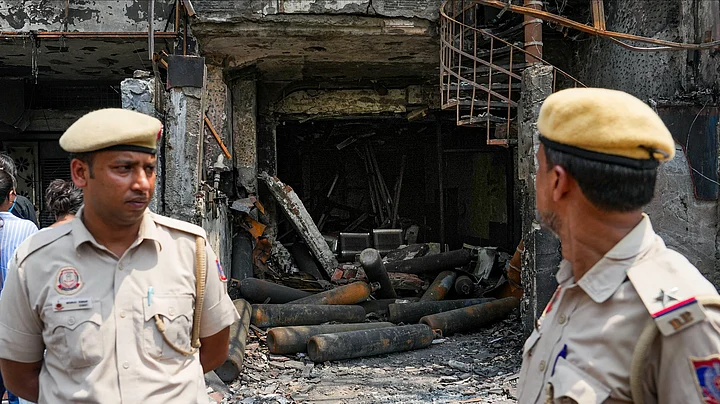What makes hospitals more prone to fire? Atul Garg, chief of Delhi Fire Services, explains to The Quint, "Hospitals typically have several equipment functioning at the same time – and they have to be handled with care."
"During summer months, there is more load due to enhanced usage of ACs and other electrical equipment, which causes an overload and subsequent short circuit,” he adds.
The blaze in Baby Care New Born Hospital in East Delhi's Vivek Vihar on 25 May that claimed the lives of seven newborn children and injured five other infants has yet again put the spotlight on fire safety in such establishments in the national capital.
Over the last two years, Delhi has reportedly seen 66 fire incidents in hospitals alone. While 30 cases were reported in 2022, 36 cases were reported in 2021.
The investigation into the recent fire in East Delhi hospital showed that the said establishment – like many others – even lacked fire safety measures.
The hospital was operating with an expired license, lacked qualified doctors, and had not obtained the mandatory clearance from the fire department. It was also found lacking basic fire safety equipment such as extinguishers and water hoses.
In 2018, a Delhi government committee headed by then Health Minister Satyendra Jain had come up with a set of guidelines to bring small hospitals and nursing homes under the umbrella of fire safety regulations. Five years later, as the recent incident has purportedly made clear, these guidelines remain on paper.
So, what do these guidelines state? And why is there such laxity in implementing these guidelines? The Quint explains.
Only 196 Out of 1,225 Hospitals in Capital Have Valid Fire Safety Clearance
Baby Care New Born Hospital in East Delhi was not the only hospital to operate without a valid fire safety clearance. As per data by the Delhi Fire Services, only 196 out of 1,225 hospitals, including private and government ones and nursing homes, in the national capital have a valid fire safety clearance (FSC). The said clearance is a must for all structures above 9 metres. But why is an FSC needed from the Delhi Fire Services?
"Essentially, a FSC essentially certifies that a building has been deemed to comply with fire prevention and safety requirements according to Rule 33 of the Delhi Fire Services Rule. Not having a clearance would automatically, therefore, mean that the establishment has not complied with fire prevention and safety requirements," Garg explains.
And how is a hospital deemed to be FSC-certified? Garg says the certification process for government and private facilities varies.
"For government facilities, frequent checks are carried out on all protocols such as a proper entry and exit door, sufficient equipment sprinklers, fire extinguishers, sprinklers, and proper wiring. A team is sent for such audits. After a report is made, with all checks in place, the FSC is handed over to the premises.”
For private facilities, Garg added, however, it is the duty of the hospital concerned to apply for the FSC, irrespective of whether their registration has expired or is valid. The FSC licence is valid for three years in case of establishments likes hospitals, hotels etc.
What did the 2018 Guidelines Say?
In 2018, the Director General of Health Services, under the Delhi government’s health department, had mandated that all hospitals that are over two storeys high or over 9 metres in height require an FSC as per the Delhi Fire Department’s existing norms.
These norms mandated all commercial buildings, including hospitals, have a 6-metre-wide access road for fire tenders, and 2.4-meter-wide corridors and 2-metre-wide staircases within the premises. They also mandated an underground 75,000-litre water storage tank in the building to deal with fire emergencies.
However, smaller hospitals and nursing homes operating from/out of residential areas in the city found it challenging to comply with these norms.
In 2019, about 600 small hospitals and nursing homes in Delhi approached the state's health department for a solution after a fire at hotel in Karol Bagh claimed the lives of 17 people.
A panel chaired by Satyendra Jain then came up with a different set of guidelines that could be implemented by smaller hospitals and nursing homes operating out of residential areas.
Among other things, the guidelines required these smaller facilities to be equipped with automatic fire alarms and sprinklers. Moreover, it scrapped the requirement of wide staircases and corridors.
However, these guidelines were never implemented. The Quint reached to the Delhi government with queries on these guidelines. The article will be updated as and when they respond.
Of Short Circuits and Hospitals Being More Prone to Fires
Garg explains that a primary cause behind fire incidents at hospitals and nursing homes is short circuits. It is made worse during the summers when the enhanced usage of ACs could cause an overload and subsequent short circuit.
He further adds, "During the blaze in the East Delhi hospital, the probe revealed that five cylinders had exploded when there was a fire in the facility, and it fanned the blaze. This is a lapse on the part of hospital authorities – and could have been avoided."
Moreover, Garg points out that while the National Building Code makes it necessary for electrical fittings and wirings to be sealed by non-combustible material in separate ducts, this is rarely the case.
"Ideally, hospitals should not use combustible materials like plaster of Paris on walls, false ceilings etc. It should instead materials that are resistant to fire such as resin sheets," he adds.
(At The Quint, we question everything. Play an active role in shaping our journalism by becoming a member today.)
